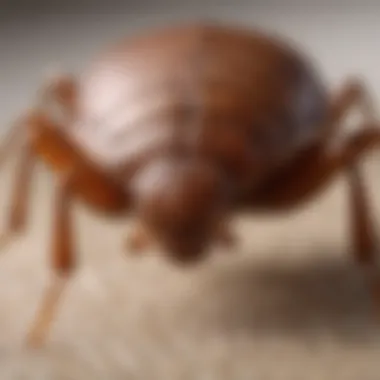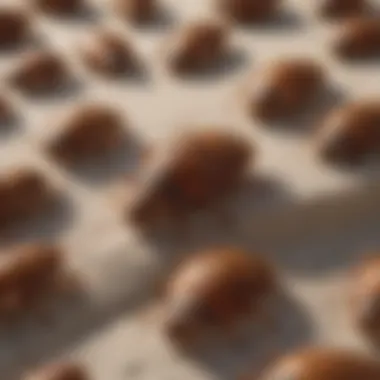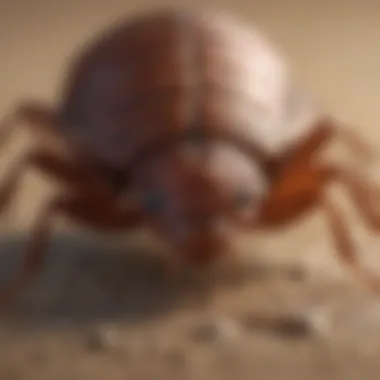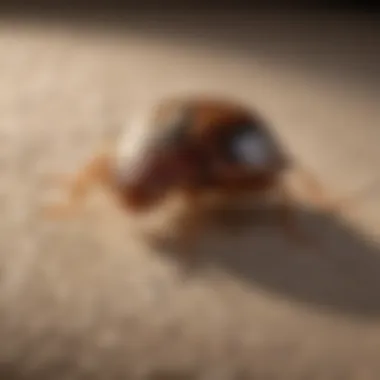Understanding Bed Bug Appearance: A Comprehensive Guide


Intro
Bed bugs are persistent pests that can cause significant discomfort and distress. Their presence is often unexpected and can lead to both physical and emotional repercussions. Early detection is crucial for effective management and prevention of infestations. Understanding how and when bed bugs appear is essential for homeowners seeking to maintain a safe and healthy living environment.
Understanding the Pest
Identification
Identifying bed bugs is the first step towards addressing an infestation. Adult bed bugs are small, approximately 4 to 5 mm in length, and possess a flat, oval shape. They exhibit a reddish-brown color, which becomes more pronounced after feeding. Bed bug nymphs are lighter in color and smaller, making them harder to spot. Detection can be further complicated by their ability to hide in crevices, making thorough inspections critical.
Key identification features include:
- Color: Reddish-brown for adults, lighter for nymphs
- Shape: Flat and oval
- Size: 4 to 5 mm in adults; smaller when nymphs
Life Cycle
Understanding the life cycle of bed bugs aids in gauging their potential visibility. Bed bugs develop through five nymphal stages before reaching maturity. Each stage requires a blood meal to advance. The duration of the life cycle is influenced by environmental factors such as temperature and humidity. Under optimal conditions, they can mature quickly, leading to increased visibility and the possibility of a larger infestation.
- Eggs: Approximately 1 mm long, white, and laid in clusters.
- Nymphs: Transition through five stages, each requiring blood to grow.
- Adults: Reach maturity in about five weeks under favorable conditions.
"Understanding the life cycle helps anticipate when bed bugs might emerge, enhancing detection efforts."
Pest Prevention Strategies
Environment Modification
Modifying the environment is a key strategy for preventing bed bugs. This includes:
- Reducing clutter: Limiting items in living spaces makes it easier to spot and control bed bugs.
- Sealing cracks and crevices: This denies them hiding spots, making infestations less likely.
- Regular cleaning: Frequent vacuuming can help capture bed bugs and their eggs before they can develop further.
Physical Barriers
Creating physical barriers can also minimize bed bug presence. Options include:
- Bed bug encasements: Protect mattresses and box springs. These covers can trap existing bugs and prevent new infestations.
- Sealant or caulk: Apply to openings around windows, doors, and baseboards, effectively cutting off entry points.
Control Methods
Chemical Control
Chemical control methods remain one of the primary approaches for managing bed bug infestations. Various pesticides are available, but caution is necessary to avoid chemical resistance. Commonly used products include:
- Insecticides: These are applied directly to affected areas.
- Dust formulations: These can penetrate into cracks and crevices, ensuring better coverage.
Biological Control
Biological control provides an eco-friendly alternative for controlling bed bugs. This may involve using natural predators or microbial agents that target bed bugs without chemical applications. Research is ongoing to identify more effective biological methods.
Preface to Bed Bugs
Understanding the nuances of bed bugs is imperative for anyone faced with the possibility of infestation. This section lays the groundwork for comprehending their characteristics, behavior, and the historical context of their presence in human living spaces.
Bed bugs, once thought to be a problem of the past, have resurfaced as a significant pest in modern homes. Their ability to adapt and survive in various environments makes them particularly insidious. Being informed about bed bugs can empower homeowners and professionals alike to take timely and effective action when signs appear. This knowledge is essential not just for pest control but also for understanding the broader implications of infestations on health and well-being.
Definition and Overview
Bed bugs, scientifically known as Cimex lectularius, are small, nocturnal insects that feed on the blood of humans and other warm-blooded hosts. Adult bed bugs are usually about the size of an apple seed, measuring approximately 4 to 5 mm in length. These pests possess a flattened, oval shape and can range in color from brown to reddish-brown, depending on their feeding status. After a blood meal, they can take on a more swollen and reddish appearance.
Bed bugs are not considered carriers of diseases; however, their bites can cause various reactions in sensitive individuals, ranging from mild irritation to more severe allergic responses. Their bites typically present as small, red welts that may itch. It is important to understand that bed bugs are not a reflection of poor hygiene or cleanliness, but rather a symptom of increased human travel and global trade.
History of Bed Bug Infestations


The history of bed bugs can be traced back thousands of years, with references appearing in ancient texts from multiple cultures. Historical records indicate that these pests were once common in homes across Europe and were prevalent during the early 20th century. A decline in bed bug populations occurred as improved sanitation practices and the advent of modern pest control methods—like insecticides—became widespread.
However, the late 20th century saw a resurgence in bed bug infestations, attributed to factors such as increased international travel, urbanization, and resistance to common pesticides like DDT. In recent years, their presence has gained significant attention, with numerous reports of infestations appearing in hotels, apartments, and even single-family homes. Understanding their historical patterns can offer valuable insights into their behavior and the challenges of managing them today.
"Bed bug infestations are a modern issue that reflects broader global trends in movement and trade."
As we continue through this guide, the exploration of their life cycle and the environmental conditions affecting their visibility will deepen your understanding of these pests, ultimately equipping you with the knowledge necessary for effective management and prevention.
Life Cycle of Bed Bugs
Understanding the life cycle of bed bugs is crucial in managing their presence effectively. This knowledge not only underscores the various stages they undergo but also highlights the duration and conditions under which they thrive. Each phase, from egg to adult, contributes to the broader understanding of how infestations can build up and the optimal points for intervention. Recognizing these stages can assist homeowners in identifying potential problems early and implementing preventive measures effectively.
Egg Stage
Duration of Egg Incubation
The duration of egg incubation for bed bugs typically ranges from six to ten days. This period is largely determined by environmental conditions such as temperature and humidity. Warmer temperatures can shorten this incubation span, facilitating quicker hatching, while colder climates may extend this duration significantly. This characteristic emphasizes the adaptability of bed bugs to their surroundings, making them persistent pests in various environments. Understanding this incubation period allows home owners to anticipate the emergence of new bed bugs, aiding in timely intervention.
Factors Affecting Hatching
Several factors play a role in the hatching of bed bug eggs. Temperature is particularly significant; optimal warmth can lead to faster hatching rates. Additionally, humidity levels contribute to the viability of the eggs. Drier conditions can cause damage to the eggs, leading to reduced hatching success. The unique feature here is that even small fluctuations in these environmental factors can impact the entire infestation timeline. If homeowners are aware of these aspects, they can create less hospitable environments for bed bugs, thus reducing their chances of multiplying.
Nymph Stages
Growth and Development
Once the eggs hatch, bed bugs enter the nymph stages, which consist of five instars. Each instar requires a blood meal to grow and molt into the next stage. This growth and development period can span several weeks, depending on the availability of food and environmental conditions. Each nymph stage presents opportunities for detection. Homeowners who know what to look for can more easily identify potential infestations before they become severe.
Environmental Influences on Nymph Appearance
Nymphs are sensitive to environmental conditions, which significantly influence their size and color. Higher temperatures often lead to faster growth rates and quicker maturation to adulthood. Conversely, unfavorable conditions can slow down their development. Recognizing how environmental elements affect nymph appearance aids in understanding the severity of an infestation and potential treatment avenues.
Adult Stage
Identification of Adults
Identifying adult bed bugs is key in recognizing an infestation. Adults are usually a reddish-brown color and about five to seven millimeters in length. The ease of spotting these mature bugs compared to nymphs makes knowledge of their appearance crucial. Homeowners should aim to catch any signs of the adult stage promptly to prevent further reproduction and spread within their living spaces.
Duration before Mating
Once bed bugs reach adulthood, the time frame before mating can vary, but it is generally within a few days after their final molt. This rapid approach to reproduction signifies the urgency of detection measures. Adults can reproduce multiple times, which can quickly escalate a minor issue into a significant infestation. Understanding this timeline helps highlight the importance of swift action and highlights the potential for exponential population growth in a short time frame.
Timeframe for Bed Bug Appearance
Understanding the timeframe for bed bug appearance is crucial for both prevention and control. By knowing how long it takes bed bugs to grow from an egg to an adult, homeowners can monitor their living spaces effectively. This knowledge allows for timely interventions. Early detection often reduces the complexity and expense associated with pest control.
Typical Timeline from Egg to Adult
The journey of a bed bug from an egg to an adult typically spans about five to six weeks under ideal conditions. Here’s a breakdown of this timeline:
- Egg Stage: The eggs hatch within about 6 to 10 days. This period can vary based on environmental conditions.
- Nymph Stages: After hatching, nymphs go through five molts before reaching adulthood. Each stage takes about 4 to 7 days. Nymphs need to feed at each stage to grow.
- Adult Stage: Once matured, an adult can live for several months, sometimes even a year in the right conditions.
This rapid growth makes bed bugs particularly alarming, as a small number can quickly multiply if not dealt with properly.
Factors Influencing Time to Visibility
Temperature
Temperature plays a significant role in the development and visibility of bed bugs. Optimal temperatures for their growth range between 70°F and 80°F. At these temperatures, the eggs hatch faster, and mortality rates decrease. Conversely, temperatures below 50°F can significantly delay growth and reduce the chances of survival. Thus, controlling the environment can slow infestations effectively.
Humidity Levels
Humidity levels also affect bed bug development. Bed bugs thrive in humid conditions, typically between 40% and 70% relative humidity. Sufficient moisture aids their molting process. Insufficient humidity can slow their development, while excessive moisture can lead to other issues, such as mold, which can complicate matters for homeowners.


Food Availability
Food availability is another critical factor. Bed bugs rely solely on blood to survive. If they have access to a human host or warm-blooded animals, their development accelerates. An insufficient supply of food will delay growth and may lead to increased mortality.
In understanding these factors, homeowners can proactively manage their environment. This includes maintaining moderate temperatures, controlling humidity, and minimizing potential feeding opportunities for these pests. Such measures significantly contribute to keeping bed bugs at bay.
"Timely intervention and awareness can prevent a small problem from escalating into a larger infestation."
Integrating these insights into routine home inspections can mitigate risks effectively, leading to a healthier living space.
Signs of Bed Bug Infestation
Recognizing the signs of a bed bug infestation is crucial for effective management. Early detection can prevent a small problem from escalating into a larger one. Bed bugs are elusive, which makes understanding these signs all the more important for homeowners. They often hide during the day and come out at night, so knowing what to look for can save one a lot of stress and cost in pest control.
Bite Marks
Bed bug bites are often one of the first signs that indicate an infestation. These bites typically appear as small, red, itchy welts on the skin. The bites may come in clusters or lines, which can help differentiate them from bites of other insects. Not everyone reacts the same way to these bites, so some individuals may not notice them at all. Affected individuals often wonder why these bites are so distinct.
Understanding bite marks is important for identification purposes. However, a physical presence of the bugs must still be confirmed for proper management. If bitten, it is advisable to keep track of any patterns, as this information is helpful for pest control experts in assessing the severity of the infestation.
Physical Evidence
Aside from bite marks, several physical indicators can testify to the presence of bed bugs in a home. Careful examination of living spaces is essential to detect such evidence.
Fecal Stains
Fecal stains are a significant physical evidence of a bed bug infestation. These tiny dark spots are usually found in areas where bed bugs reside, such as seams of mattresses, bed frames, and nearby furniture. Their presence indicates that the bugs are feeding and excreting waste products. Fecal stains are a useful tool for detection because they are challenging to remove and can remain long after bed bugs have left an area.
A key characteristic of fecal stains is that they can resemble ink drops or tiny smears. They often accumulate over time, making it easier to confirm the presence of these pests. In this context, fecal stains serve as a beneficial indicator for homeowners. They signal the need for immediate inspection or treatment.
Molted Skins
As bed bugs grow, they shed their skins, leaving behind molted exoskeletons. These remnants can also serve as indicators of an ongoing infestation. The presence of molted skins highlights the bugs' growth stages and the fact that they are likely reproducing. Unlike fecal stains, molted skins can be more visible due to their larger size.
The key feature of molted skins is their shell-like appearance. Homeowners can easily spot these in places where bed bugs are likely to hide. This makes them a popular choice for identifying an infestation. It confirms that bed bugs are not only present but also thriving in the environment.
Egg Casings
Bed bug egg casings are another significant sign of an infestation. Each casing contains the remains of an egg that has hatched, pointing to successful reproduction within the home. Homeowners may find these white, tiny casings in the same areas as fecal stains and molted skins.
The key characteristic of egg casings is their shape and size. They are typically smaller than the size of a pinhead and appear in clusters. Finding these casings suggests a potential for rapid population growth. This makes them a concerning indicator for anyone suspecting a bed bug problem. It brings attention to the need for immediate action in pest management.
Preventative Measures
Preventative measures play a vital role in managing bed bug infestations. Understanding these steps is crucial for homeowners. The significance lies in reducing the chances of an infestation and ensuring the comfort and safety of your living space. Effective prevention can save resources, time, and emotional distress.
Regular Inspections
Conducting regular inspections is one of the most effective ways to keep bed bugs at bay. It involves dedicated time to check mattresses, bedding, furniture, and nearby areas. An early detection can lead to a swift response if bed bugs are found. Make it a habit to inspect your home every few weeks. This practice can reduce the risk of a broader infestation, as bed bugs can spread quickly once established.
Maintaining Cleanliness
Maintaining cleanliness is more than just surface-level tidiness. It involves a thorough approach to your living space, especially in areas like bedrooms where bed bugs often thrive.
Bed and Bedding Care
Focusing on bed and bedding care is essential. Regularly laundering sheets and pillowcases in hot water can help eradicate potential bugs. A key characteristic of this practice is its direct impact on reducing infestation risks. Clean bedding is a simple and effective method of prevention. The unique feature here is the methodical care of materials that can harbor bugs. This leads to substantial advantages, including peace of mind and a healthier sleeping environment.
Minimizing Clutter
Minimizing clutter should also be a priority in your preventative measures. Clutter provides hiding places for bed bugs. Keeping a tidy space makes it easier to spot signs of bed bugs. The main characteristic of minimizing clutter is its role in simplifying your living area. This also makes cleaning easier and enhances the overall functionality of your space. The unique feature of this approach is the mental clarity it provides, in addition to the physical benefits. This might require some effort, but the long-term advantages include fewer places for bed bugs to hide, potentially preventing a future infestation.
"An ounce of prevention is worth a pound of cure." - Benjamin Franklin


Pest Control Strategies
Pest control strategies are essential in managing bed bug infestations, especially due to their resilience and ability to multiply rapidly. Understanding these strategies can aid homeowners in preventing and eradicating these pests effectively. Employing a combination of professional extermination options and DIY solutions can maximize the chances of successful control.
Effective control strategies not only eliminate the current infestation but also create an environment less conducive to future outbreaks. Homeowners must consider both the effectiveness and safety of these methods, particularly in homes with children or pets. Such considerations are vital in order to promote a healthy living space.
Professional Extermination Options
Professional extermination is often the most effective approach for significant infestations. Experts utilize specialized equipment and insecticides that are not available to the general public. These professionals are trained to identify infestation hotspots and can apply targeted treatments. One major advantage includes the ability to access hard-to-reach areas, such as within walls or furniture.
Typically, a pest control service will conduct a thorough inspection first. After identifying the extent of the infestation, they may use methods such as chemical sprays, vacuuming, or thermal treatments. While this may require a financial investment, the peace of mind that comes with trained expertise is invaluable. Always ensure to choose a licensed and experienced pest control professional.
DIY Solutions
Heat Treatment Methods
Heat treatment methods leverage high temperatures to kill bed bugs in all life stages. This method involves raising the temperature in an infested space to around 118°F (48°C) for a sustained period. A key characteristic of heat treatment is its non-chemical approach, making it a popular choice among homeowners who prefer to avoid pesticides.
This method’s unique feature lies in its ability to penetrate furniture, carpets, and other hiding spots. The effectiveness of this treatment can be advantageous; however, it often requires professional equipment. Additionally, care must be taken to protect belongings that can be damaged by heat.
Nontoxic Alternatives
Nontoxic alternatives are gaining attention for their eco-friendly properties. These solutions can include natural essential oils, diatomaceous earth, or steam. The main characteristic of these alternatives is their safety for use in homes with children and pets, offering peace of mind to parents and animal owners.
A distinctive feature of these methods is that they often focus on prevention rather than elimination. For instance, diatomaceous earth disrupts the exoskeleton of bed bugs, leading to dehydration. While they may not be as immediately effective as professional treatments, combining these solutions with persistence can show good results over time. However, users should be aware that these methods can take longer and may not resolve significant infestations quickly.
"Prevention is better than cure; applying multiple strategies can help maintain a bed-bug-free environment."
Thus, combining professional approaches with DIY solutions can create a comprehensive plan to combat bed bugs effectively.
Impact of Environmental Factors
Understanding the impact of environmental factors is crucial in comprehending bed bug populations and their visibility. Various elements such as climate, temperature, and seasonality directly influence the behaviors, lifespan, and lifecycle progression of these pests. Assessing the role of the environment provides valuable insights into effective control strategies and prevention measures.
Climate Influence on Bed Bug Lifespan
The climate plays a significant role in the lifespan of bed bugs. Warm and humid environments boost their growth rates and reproduction. These insects thrive at temperatures between 70°F and 80°F (20°C to 27°C). In contrast, extreme temperatures can extend or shorten their life cycles. For example, cold conditions below 50°F (10°C) can significantly inhibit their activity and reproduction. Conversely, exposure to high heat, above 113°F (45°C), can be lethal. Understanding these thresholds can help homeowners determine suitable environments for bed bug management.
Factors that affect the climate's influence on bed bugs include:
- Temperature Fluctuations: Sudden changes can disrupt their life cycle.
- Humidity Levels: Higher humidity levels support bed bug activity while dry conditions can lead to desiccation.
- Indoor vs Outdoor Environments: Bed bugs often retreat to more favorable microclimates within homes, affecting visibility.
Seasonal Variations in Appearance
Seasonal changes can also lead to variations in bed bug populations. During warmer months, their activity typically increases, as this is when they are more likely to reproduce and infest dwellings. Moreover, travel peaks during vacation seasons can introduce new bugs into homes.
- Spring and Summer: These seasons create optimal conditions for reproduction. Bed bugs are most visible in these months due to increased rates of hunting for food.
- Autumn and Winter: Infestations may decline during colder months. However, many individuals remain hidden within furniture or bedding, leading to the idea that they have disappeared. This is a common misconception; they simply become less active.
Understanding these seasonal patterns allows homeowners to be proactive rather than reactive when it comes to bed bug management.
Closure
The conclusion serves as a crucial focal point in this article, offering a comprehensive summary of the information presented about bed bugs. Understanding their appearance is more than just a matter of identifying these pests. It connects to larger themes of prevention, detection, and management, illustrating the serious nature of bed bug infestations in homes.
Summary of Key Insights
In summary, several key insights emerge from the discussion:
- Life Cycle Awareness: Recognizing the stages in the life cycle of bed bugs allows homeowners to understand when infestations may occur and how to address them effectively.
- Environmental Factors: The influence of temperature, humidity, and even seasonal changes shows that awareness of environmental conditions can support more proactive management strategies.
- Signs of Infestation: Through careful observation of bite marks and physical evidence such as fecal stains or molted skins, individuals can take early action to mitigate an infestation.
These elements emphasize the need for vigilance and knowledge in combating bed bugs, leading to better prevention methods and more effective pest control strategies.
Future Considerations in Bed Bug Management
As we look forward, several future considerations can enhance bed bug management.
- Research Developments: Continuing research into bed bug behavior and biology will enable the development of more targeted treatments. This can also lead to innovative detection methods that enhance early identification.
- Community Awareness Programs: Increasing awareness through educational programs can equip homeowners with information to recognize the signs of bed bugs earlier, improving the chances of containment.
- Sustainable Practices: The importance of adopting environmentally-friendly pest control approaches cannot be overstated. Emphasizing non-toxic solutions can protect not only human health but also the environment.
Ultimately, understanding bed bug appearance and lifecycle is integral to managing these pests effectively. The information gathered in this article positions homeowners to take informed actions and minimize the impact of infestations in their living spaces.







